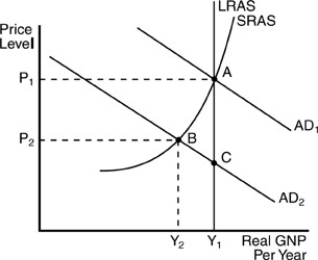Multiple Choice

-In the above figure, start with the economy in equilibrium at point A. Then an unanticipated reduction in aggregate demand triggers a shift from AD1 to AD2. In the short run, this would cause
A) the price level to fall from P1 to P2, real Gross Domestic Product (GDP) to fall from Y1 to Y2, and the rate of unemployment to increase.
B) the price level to move from P1 to P2, but real Gross Domestic Product (GDP) would stay at Y1.
C) the price level to fall by some amount less than P1 but greater than P2, and the rate of unemployment would decrease.
D) no change in either the price level or real Gross Domestic Product (GDP) , but a decrease in unemployment.
Correct Answer:

Verified
Correct Answer:
Verified
Q22: Which of the following curves shows the
Q38: When the economy is at its natural
Q97: If you accept the rational expectations hypothesis
Q104: When it comes to active policymaking most
Q179: Available evidence about price adjustments across U.S.
Q199: Which statement is true when rational expectations
Q207: <img src="https://d2lvgg3v3hfg70.cloudfront.net/TB5013/.jpg" alt=" -Refer to the
Q236: The hypothesis that people combine the effects
Q264: The hypothesis stating that people combine the
Q308: Menu costs are a possible reason for<br>A)